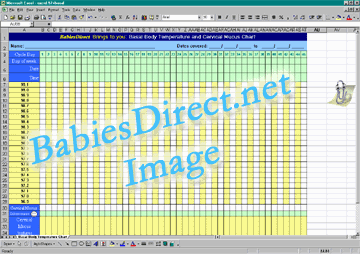What is Basal Body Temperature?
Basal Body Temperature (or BBT) is the temperature of the body when at rest. Tracking of the BBT by using this method requires charting your basal body temperature when you’re body is completely at rest. Most women’s temps BEFORE ovulation are around 96 – 98F and 97 – 99F after ovulation. By charting the differences in one tenth(1/10th) degree increments, you can determine when you could possibly be ovulating OR when it has taken place. Here’s an example of a conception chart
Download Basal Body Temperature Sheets
- Microsoft Excel Format
- Excel 97/2000 BBT Sheet
- Excel 95 BBTemperature Sheet
- Excel 4.0 BBT Worksheet

Click on Image to See it Full Size
One of the many changes that take place in a woman’s body during her menstrual cycle is an increase in body temperature at the onset of ovulation. During the first the first part of a woman’s cycle, the body temperature is lower. With ovulation, the body temperature rises (to create a more fertile environment for the fertilized egg) and remains higher until the beginning of a woman’s next cycle.
Recording each day’s body temperature – and charting the patterns of temperature change – will help pinpoint when when ovulation has occurred.
Because BBT charting allows a woman to confirm the onset of ovulation, it is a very useful method in helping facilitate conception – as well as understanding the general patterns and nuances of a woman’s menstrual cycle.
During the first two weeks of a woman’s cycle, her body temperature is lower (97.0 to 97.5 F), due to the presence of estrogen. With ovulation, a rise in body temperature takes place – caused by an increase of the hormone progesterone – in order to provide a warmer, more fertile environment in the womb. A minimum temperature rise of 0.4 to 0.6 degrees Fcan be measured – and this change will last through the duration of the menstrual cycle. By monitoring when this temperature change takes place, you can estimate when ovulation has taken place.
How to take your Basal Body Temperature
- Purchase a basal body temp (Basal Body Temperature)thermometer.
- Obtain a Basal Body Temperature chart from your doctor, or download one from here.
- Before bedtime, place Basal Body Temperature chart, a notepad and pen on bedside table or floor.
- At bedtime, prepare your thermometer: if mercury, shake down below 98 degrees.
- Place thermometer within arm’s reach on bedside table or floor.
- Upon waking in the morning, immediately reach for thermometer before doing anything else.
- Insert thermometer into mouth, under tongue.
- If mercury thermometer, leave in mouth for 5 minutes.
- If digital thermometer, leave in mouth until indicator (usually a beep) signals you.
- After 5 minutes or the signal sounds, take thermometer out of mouth and look at the reading under good light.
- Jot down date and temp reading on notepad.
- Scribble a pen dot on the graph line where the date and temperature meet.
- After you have more than one temp graphed, connect the dots with a line.
Other Tips
Do not do anything else before placing thermometer in your mouth. If possible, don’t move any body part other than your reaching arm.
Jot down temperature reading immediately; do not depend on your memory.
Your Basal Body Temperature can be taken orally with a special BBT thermometer. Ideally, a larger thermometer that registers from 96 to 100 degrees (in easy-to-read one-tenth degree increments) is recommended. Digital thermometers are also available. Remember, you are attempting to discern as little as a two-tenths of a degree of difference in temperature, so selecting a quality thermometer and following directions are crucial.
Important: Your BBT temperature refers to a ‘resting’ or ‘base’ temperature. That means that your BBT must be measured prior to any physical activity, after at least three to four hours of sleep. Make sure that you read thermometer directions – and if you have any questions or unique considerations, consult your physician.
1. Taking Your BBT Temperature
Take your BBT temperature first thing each morning – as soon as you wake up. It is recommended that you remain in bed (as any physical activity can increase your resting temperature), as well as avoid eating or drinking. Coffee can wait! Either insert the thermometer in your mouth – or alternatively your rectum – and wait five minutes. Read the temperature to within 1/10 of a degree and record the reading.
2. Charting Your BBT Temperature
Starting on day one of your menstrual cycle – the first day of your period – begin recording your BBT temperature using a calendar or notebook and graph paper. Each morning, record your temperature. Plot each day’s BBT on the graph. Your temperature rise may be sudden, gradual, or in steps. The pattern may vary from cycle to cycle.
3. Predicting Ovulation
For most women, 96 to 98 degrees is considered normal prior to ovulation and 97 to 99 degrees after ovulation. By charting the differences – in one-tenth degree increments – you can determine when ovulation has taken place.Typically a rise of at least 0.4 to 0.6 degrees will take place at ovulation, though for different women the temperature increases may be sudden or gradual.
